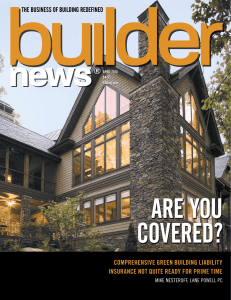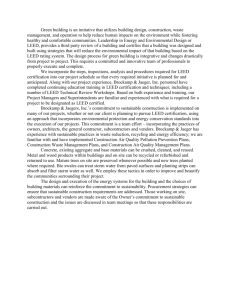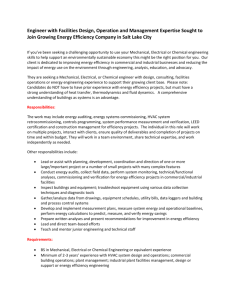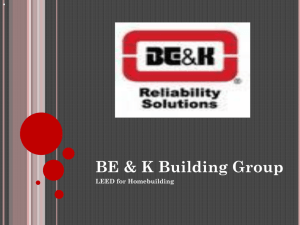Module 3 Slides
advertisement
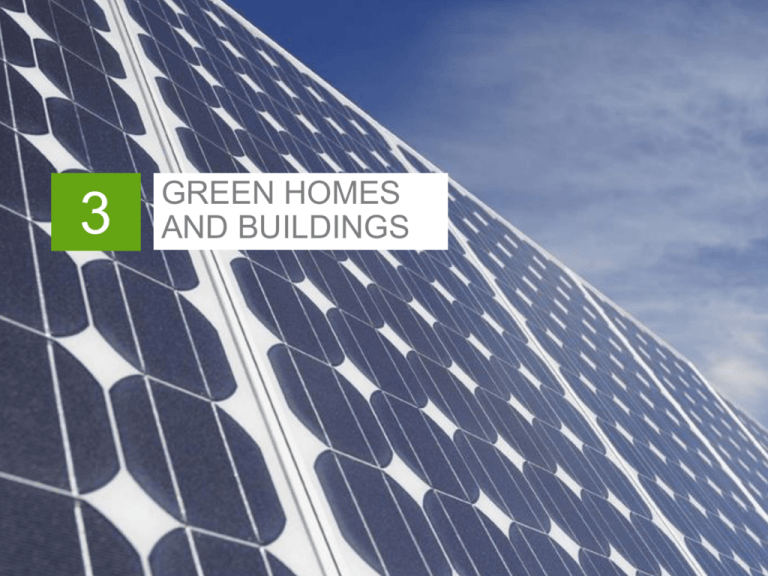
3 GREEN HOMES AND BUILDINGS In This Chapter 3-1 What makes a home or building green? Green design principles Green construction principles Building envelope Systems Landscaping Cost/benefit Green vendors What Makes a Home or Building Green? For many consumers, “greenness” determined by whether home or building: 3-2 is LEED certified is ENERGY STAR qualified has a HERS rating LEED Certification Third-party certification program Sets design, construction, and operational standards for high performance green buildings Awarded by the U.S. Green Building Council 3-3 LEED Certification Available for: New construction and major renovations Existing buildings Commercial interiors Core and shell Schools (K–12), retail, healthcare Homes Neighborhood development 3-4 LEED Certification Properties qualify by earning points in: Sustainable sites Water efficiency Energy and atmosphere Materials and resources Indoor environment quality Innovation and design process 3-5 LEED Certification Available certifications: Certified Silver Gold Platinum 3-6 Case Study 3.1 National Association of REALTORS® Washington, D.C. headquarters First newly constructed building in metropolitan Washington area to receive LEED silver status from USGBC 3-7 Case Study 3.1 Landscaping plan using native plant species Efficient HVAC systems and a highperformance glass curtain wall Zero use of CFC-refrigerants High-recycled building materials Carbon dioxide monitoring system 3-8 LEED Certification Time-intensive and complex process Detailed documentation required Independent verification must be completed by LEED AP 3-9 ENERGY STAR Popular program that helps consumers identify energy-efficient products Also a qualification awarded to homes and buildings 3-10 ENERGY STAR Qualified Homes 15% more energy efficient Available for homes of three stories or less, including: – – – – – – – 3-11 Single Attached Low-rise multifamily Manufactured Modular Log Concrete ENERGY STAR for Buildings Available for commercial, industrial, and institutional buildings Uses point scale that analyzes energy efficiency and indoor environmental quality 3-12 Home Energy Rating System nose 3-13 Energy-evaluation standard maintained by RESNET Base line rating is 100, which represents standard new home Rating of 0 represents a zeroenergy home Different Shades of “Greenness”? Are homes and buildings without a national certification less green? Depends on who you ask Green homes and buildings share: 3-14 – Integrated into environment – Achieving sustainability – Positively impacting human health and comfort The Green Home or Building 3-15 Green Design Principles Design choices not made in isolation Home or building is interconnected with neighborhood, community, and earth 3-16 Integrated Design Team Developer Interior designer Architect Acoustical designer Contractor Lighting designer Landscape architect Property manager Structural engineer Maintenance engineer Mechanical engineer Plumber Other real estate professionals 3-17 General Goals of Design Team Reduce exposure to toxic materials Conserve energy and resources Minimize ecological impact Use renewable energy and materials Sustainably harvested Sustainably manufactured Protect and restore ecosystems Support alternatives to fossil-fueled vehicles 3-18 Source: American Institute of Architects, www.aia.org Green Design Factors 3-19 Size Community impact and relationships Climate Sun Lighting Water Material selection Connection to nature Aesthetics Myth: green homes and buildings must look “unattractive” or “unappealing” Appealing aesthetics ensure longevity ASID & USGBC REGREEN Residential Remodeling Guidelines , Case Study Home – Major Addition 3-20 Source: Reprinted with permission of the American Society of Interior Designers, Inc. and U.S. Green Building Council, “REGREEN Guidelines 2008,” www.regreenprogram.org. Green Construction Principles Careful planning, coordination, and monitoring Real estate professional can: Become familiar with differences between conventional and green construction Converse with architects, contractors, inspectors Ensure proper documentation 3-21 Selecting and Using a Site Local and regional green goals Sustainable orientation of building on site Storm water management 3-22 Building Materials and Methods Advanced framing techniques Sourcing of materials FSC (see Figure 3.6) Green Seal (see Figure 3.7) Low-VOC materials Low-waste construction 3-23 Exercise: Reducing Construction Waste Old growth timber Uncontaminated wood Structural steel Drywall Cabinet fixtures Excess insulation Packaging materials 3- Excess paint Use in interior walls as noise-deadening materials Clean and use as high-quality architectural millwork Remix and store for touch-up work Return to supplier for reuse or recycling Donate to nonprofit organization for home remodeling for low-income family Shred for mulch De-paper and crush gypsum to use as soil amendment in moderate quantities Recycle Building Envelope Separates exterior from interior Consists of: 3-25 Below-grade systems Exterior walls Fenestration systems Roofs Environmentally Friendly Materials Materials for construction of building envelope 3-26 Formaldehyde-free insulation Low- or no-VOC adhesives, caulks, and sealants FSC-certified wood Wood I-joists (see Figure 3.8) Source: Alameda County Waste Management Authority & Source Reduction and Recycling Board, Home Remodeling Green Guidelines, www.stopwaste.org. HVAC Must be rightsized Heating, cooling, and ventilation systems must be appropriate for climate and structure HVAC must integrate with building envelope 3-27 HVAC Energy-efficient technologies: 3-28 Radiant floor heating (see Figure 3.9) Active solar heating Evaporative cooler (see Figure 3.10) Sources: The Aldo Leopold Foundation, Leopold Legacy Center Construction Journal, Report 15.2—Mechanical Systems, www.aldoleopold.org. California Energy Commission, Consumer Energy Center, www.consumerenergycenter.org. Indoor Air Quality (IAQ) Serious concern for many consumers Poor IAQ results in reduced productivity and adverse health effects 3-29 Indoor Air Pollutants and Sources Combustionrelated Oil, gas, kerosene, cigarettes, burning wood Asbestos Certain insulations, shingles, millboards, floor and ceiling tiles Paints, lacquers, paint strippers, adhesive removers, carpet, cleaning supplies, pesticides, wood preservatives, furniture, cabinets Lead-based paint, contaminated soil, dust, and drinking water Insecticides, termiticides, and disinfectants VOCs Lead Pesticides Radon Mold 3-30 Earth and rock beneath home, well water, building materials Outdoor environment Reducing Off-gassing Use: 3-31 Low- or no-VOC paints and adhesives Low-VOC wallpaper Boards certified to lowformaldehyde standards “Green Lablel” carpeting and adhesives Achieving Good IAQ Foundation Impermeable to moisture and air Radon-resistant Inhospitable to pests Free or low in VOCs Framing 3-32 Insulated with low-formaldehyde emission standards Constructed with high efficiency windows Weatherstripped and air-sealed Achieving Good IAQ HVAC 3-33 Sealed ducts and air handlers Duct mastic on duct joints Corrosion-resistant coil drain pans Dehumidification equipment within thermal enclosure Insulated ducts, plenums, and trunks EPA-certified wood-burning fireplaces High efficiency filters Make-up air for components such as furnaces Solar attic fan Whole-house fan Lighting Daylighting Reduces energy consumption Optimizes livability and productivity Decreases need for power generated by pollutant-emitting plants Other lighting fixtures IC-AT recessed lighting fixtures CFLs LED lamps Dimmers, timers, photosensors, motion detectors 3-34 Energy Diagnostics Energy model Energy assessment 3-35 Balometer Power meter Blower door (Fig. 3.13) Pressure meter Coheat test Thermal infrared camera Duct blaster (Fig. 3.14) Electric moisture meter Blower Door Test 3-36 Source: Reprinted with permission of NAHB Research Center’s Tool Base Services, www.toolbase.org/PDF/Bestpractices/DiagnosticTools.pdf Duct Blaster Test 3-37 Thermal Infrared Camera and Imaging 3-38 Source: Reprinted with permission of NAHB Research Center’s Tool Base Services, www.toolbase.org/PDF/Bestpractices/DiagnosticTools.pdf Water Conservation and Management Storm water management Landscaping Water-conserving toilets Flow-reducing showerheads Chlorine filter on showerheads Insulation on hot and cold water pipes Water filtration on faucets 3-39 Dishwashers Low-flow aerators on faucets Efficient appliances Washing machines Water heater jacket insulation On-demand hot water circulation pump Solar water heating Greywater reuse Greywater Non-industrial wastewater May be used in applications that do not require potable water Qualified professionals should be consulted 3-40 Landscaping 3-41 Use existing site Use native plants Group plants Employ xeriscaping Use adequate amounts of mulch Mulch with recycledcontent or reused materials Compost Use organic fertilizers Incorporate passive solar design Install a green roof Green Roof 3-42 Source: Reprinted with permission of American Society of Landscape Architects, www.asla.org. Waste Management and Recycling Convenience of recycling 3-37 Built-in recycling center Allows waste to be separated easily Cost/Benefit Usually a cost premium Direct, tangible benefits Unit and installation costs Utility savings Indirect, intangible benefits 3-44 Eco-friendliness Improved health and comfort Life-cycle Cost Analysis Total cost of a home or building, its materials, and its systems Initial Energy and water Operation, maintenance, and repair Capital improvement and replacement Conversion or disposal Other costs Example: ground-source thermal pump 3-45 Cost/Benefit Talking Points Specific appliances Value perception Design and engineering Testing Rebates and incentives 3-46 Remodeling and Retrofitting Up-front costs Financial incentives and benefits Long-term payoffs Reduced insurance costs Cost segregation Green upgrades instead of certification Sealing air leaks CFLs, occupancy sensors Certified green cleaning products 3-47 Green Vendors Finding green vendors USGBC LEED AP Directory Professional Associations Working with green vendors 3-48 Research thoroughly Ask questions

